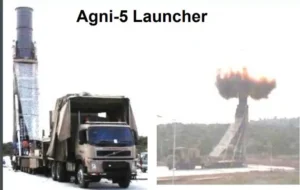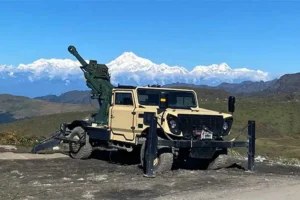In what could usher another round of tensions between Russia and the United States, a Kremlin statement on October 24 stated that Russia has successfully tested its ability to launch a massive nuclear retaliation strike by land, sea, and air.
This show of power coincided with Moscow’s de-ratification of a historic nuclear test ban pact. Putting all speculations about Moscow’s intent to abide by the test-ban treaty to rest, the state Duma passed a law on the same day as the test was conducted, withdrawing its ratification.
Announcing the law’s passage amid a new chill in relations between the two Cold War adversaries, Deputy Foreign Minister Sergei Ryabkov said that his country is not ready to begin nuclear talks with the United States until Washington abandons its “hostile” stance.
The development comes days after Russia was attacked by the long-range ATACMS missiles delivered to Ukraine by the United States and with Russians constantly dissuading the US-led NATO from arming Ukraine with munitions capable of attacking territories directly under Moscow’s control.
After passing unanimously in the lower house, the bill to de-ratify the Comprehensive Nuclear Test Ban Treaty (CTBT) was approved by the upper house by 156 votes to 0. The approved legislation will now be sent to Russian President Vladimir Putin for final approval.
Against that backdrop, Russian Strategic Deterrence Forces practicing a massive nuclear retaliation strike assumes significance. The drill, which included long-range bomber aircraft, nuclear submarines, and land-based silos firing test missiles, occurred when Moscow and the West were engaged in what Moscow perceives as an existential standoff over Ukraine.
The strategic deterrent forces are a part of the Russian Armed Forces, and their purpose is to prevent aggression against Russia and its allies and defeat the aggressor in a war using a variety of weapons, including nuclear weapons.
In what could usher another round of tensions between Russia and the US, Russia has successfully tested its ability to launch a massive nuclear retaliation strike by land, sea, and air. pic.twitter.com/71yxjGNCvQ
— EurAsian Times (@THEEURASIATIMES) October 26, 2023
“Practical launches of ballistic and cruise missiles took place during the training,” the Kremlin said in a statement on the nuclear drills. The commentary from the testing side, as reported by RIA Novosti, noted, “During the events, the level of preparedness of military management bodies, the skills of the leadership and operational staff to organize the management of subordinate troops (forces) were checked,” the commentary says.
Russian President Vladimir Putin reportedly watched the country’s strategic deterrence forces exercise via video conferencing, joining from the Kremlin’s situational center. The President was briefed on the reports by Defense Minister Sergey Shoigu and Chief of the General Staff Valery Gerasimov.
The launch of the ballistic missile “Sineva” from the nuclear submarine “Tula”. pic.twitter.com/UTDVWi28BV
— Sprinter (@Sprinter99800) October 25, 2023
As part of the training, ballistic and cruise missiles were launched. “The Sineva ballistic missile was launched from the nuclear missile submarine cruiser “Tula” from the Barents Sea,” the Kremlin noted.
In addition, the Yars intercontinental ballistic missile (ICBM) was launched from the Plesetsk Cosmodrome at the Kura test site in Kamchatka. The Russian Tu-95MS long-range aircraft, which forms the backbone of Russia’s strategic bomber fleet, were also involved in these maneuvers, launching air-based cruise missiles.

The defense ministry released video footage of the drills, which featured nuclear-capable bomber planes taking off from an airport in the dark and land- and submarine-based missiles loudly shooting into the night sky. Russia periodically conducts such exercises to test its nuclear triad. The US also runs regular nuclear drills.
All the practical launches were controlled by the National Center for Defense Management of the Russian Federation, according to a report in the Russian media. The reports said, “The tasks planned during the training are fully completed.”
According to Russia’s Minister of Defense Sergei Shoigu, the exercise’s goal is to practice “dealing a massive nuclear strike with strategic offensive forces in response to a nuclear strike by the enemy.” However, pro-US military watchers lamented the test on social media as yet another attempt by Russia at nuclear saber-rattling and escalation.
Russia’s Nuclear Strike Test Follows Its Nuclear Strike Threats
Ever since Russia launched the invasion of Ukraine, the use of nuclear weapons has become a recurrent discussion, with the nuclear threat never entirely off the table.
Since Russia launched its so-called ‘special military operation’ against Ukraine in February 2022, high-ranking officials and personnel have often indulged in nuclear saber rattling, making bellicose statements, and threatening its enemies with tactical nuclear weapons.
In March 2022, Russian President Vladimir Putin put the country’s strategic command on alert, evoking concern that he could order the deployment of tactical nuclear weapons. In response to that threat, UN Secretary-General Antonio Guterres said, “The prospect of nuclear conflict, once unthinkable, is now back within the realm of possibility.”

Since the invasion started, Russian officials have threatened a nuclear strike on Ukraine and NATO countries several times, some subtle and indirect, while others were more belligerent and direct. This has been accompanied by the country’s strategic forces often brandishing its weapons and threatening to leave treaties that ban nuclear testing.
The nuclear retaliation strike drill comes days after the Russian defense ministry said it had kickstarted the production of the first serial Sarmat intercontinental ballistic missiles. These missiles are poised to be deployed for active service shortly. The Sarmat missile, designed for deployment in underground silos, is reported by Russian authorities to be able to transport a maximum of 15 nuclear warheads.
Additionally, Putin earlier this month announced that Russia had successfully tested an experimental nuclear-powered cruise missile. Without providing more details, he stated, “We carried out the last successful test of the Burevestnik nuclear-powered global-range cruise missile.” His statement said the Burevestnik — also known as the “Storm Petrel” — was successfully tested for the first time.
Little is known about the weapon since it was first mentioned by Putin in 2018. At the time, Putin said the missile would have an infinite range and be able to circumnavigate the world without being detected by missile defense systems.
Announcing the testing of this secret missile, Putin had warned that the country’s parliament could revoke its ratification of a treaty banning nuclear tests. More such testing and drills may be in the works with its withdrawal now confirmed.
Source link







